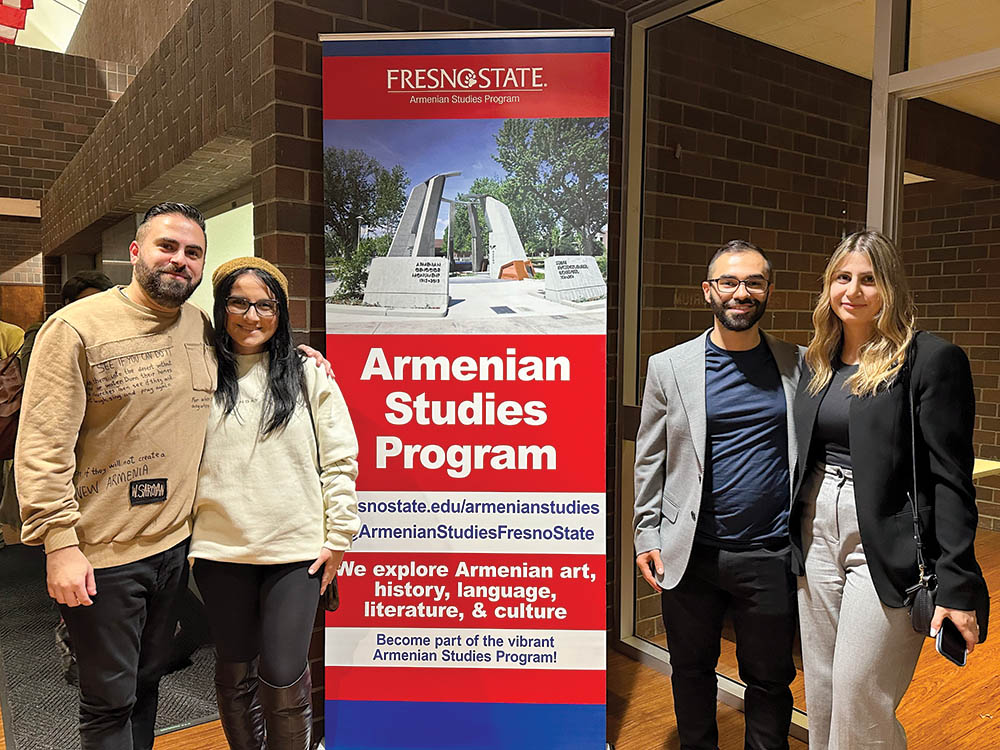
Natalie Agazarian
Editor
Tasting grandpa’s fresh apricots and black plums, playing the tunes of childhood on grandma’s old piano, walking past the water fountain by an all too familiar route – “Back to Ashtarak” is a documentary film brimming with nostalgia. It is a compilation of archival and recent footage, with unique animation that captivates the audience through its depiction of the innocence and simplicity of childhood.
On Friday, March 10, the Armenian Studies Program organized the Fresno premiere of “Back to Ashtarak,” directed by Tigran Nersisian and produced by Armen Karaoglanian. Both were present at the Friday night screening to discuss the film with the audience. The screening was co-sponsored by the Hamazkayin Fresno Taniel Varoujan Chapter.
Nersisian was born in Ashtarak and later moved to Russia at the age of five. Between COVID-19 and the recent wars in the region, Nersisian, like many Armenians, experienced feelings of disconnection from his homeland. These overwhelming emotions caused him to return to Ashtarak, where he decided to document his experiences. While the project initially started out as a form of personal reminiscence, it soon became an artistic expression for Nersisian to highlight the “celebration of Armenian culture and family.”
The short film was recorded and edited in a documentary style and is approximately thirty minutes long. Nersisian incorporated various filming techniques to capture his personal story, elements of Armenian culture, and efforts to unite the Armenian diaspora. The actual process of filming and editing the documentary lasted approximately a year, with ten days spent filming in Ashtarak and the remainder of the time spent editing.
When Nersisian posted his video online, it garnered the attention of producer Armen Karaoglanian. After coming across Nersisian’s short film, Karaoglanian felt “immediately connected” with the work, even though he had never been to Ashtarak or Armenia. Karaoglanian co-founded the Ar-menian Film Society in Glendale along with his wife, Mary Karaoglanian. It is Karaoglanian’s goal to connect Armenians in film and Armenian filmmakers, which is why he strives to share these films with other communities.
In the past year, Karaoglanian and Nersisian have traveled to UC Irvine, UCLA, Fresno State, USC, and UC San Diego to present “Back to Ashtarak.” Karaoglanian and Nersisian hope to foster unity in the Armenian diaspora by capitalizing on a common feeling: love for the motherland.
Ashtarak is a town northwest of Yerevan, Armenia. The name “Ashtarak” translates to “tower,” as one of the monasteries in the area served as a fortress in the 9th century. The region is home to many Armenians, some of whom moved there after the defense of Van in 1915. One of the main geographical landmarks of the region is the gorge that separates the old and new parts of the city. The two sites are connected by the Old Bridge, which was built in 1664 and spans over the Kasagh River. The bridge features three distinctive arches, each a different size. Nersisian commented that he admired the “connection to the past” that Ashtarak seems to transport him to, with its many buildings from the 5th century.
Like many regions in Armenia, Ashtarak is sprinkled with churches amongst its verdant and mountainous plains. Three of its well-known churches include: Tsiranavor (the apricot church), Karmravor (the red church), and Spitakavor (the white church). These churches are named after an old Armenian tale, where there were three sisters. One sister wore an apricot-colored dress, one sister wore a red dress, and the other sister wore a white dress. In a tragic series of events, the three sisters were all in love with the same man. The older two sisters wanted to ensure their younger sister’s happiness, so they sacrificed themselves by throwing themselves into the Ashtarak gorge so that the youngest sister could be happy with the man she loved. The younger sister tragically also threw herself into the gorge, because she could not bear to live without her sisters. Nersisian animated this legend in his short film, and maintained the theme of innocence by modifying the tale. In his illustrations, each sister became an angel, rather than depicting each sister’s demise. This aspect of Nersisian’s film emphasizes three important elements: the landmarks of Ashtarak, the rich cultural and religious history of Armenia, and the personal style of Nersisian’s work.
Not only did Nersisian incorporate footage from his childhood, latest travels, and animations, but he also included interviews with Ashtarak locals. “Ashtarak is my cradle and my homeland,” said one woman. Another Ashtarak resident described the region as having an “ancientness that will be valued.”
“Back to Ashtarak” serves as Nersisian’s personal homage to his childhood, and beyond that, an intercessor between the people of the Armenian diaspora and the motherland. The visual narration of the rich history, youthfulness, and connection to Armenia is fused by a final comment from Nersisian that “Ashtarak is impossible to describe, only to feel.”
 Hye Sharzhoom Armenian Action
Hye Sharzhoom Armenian Action